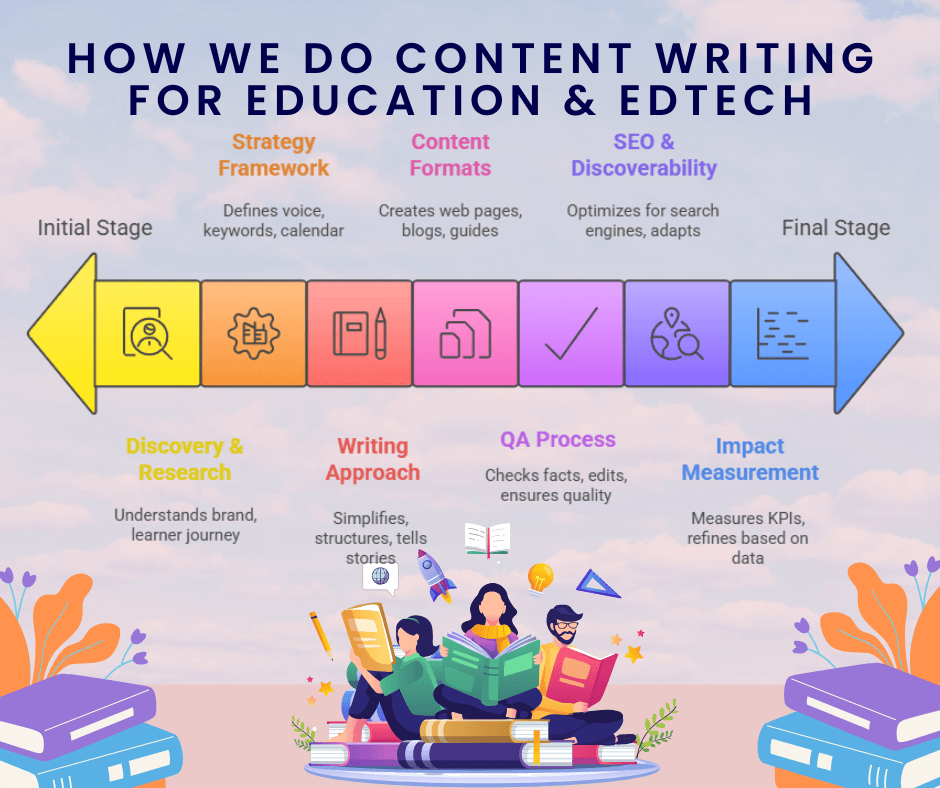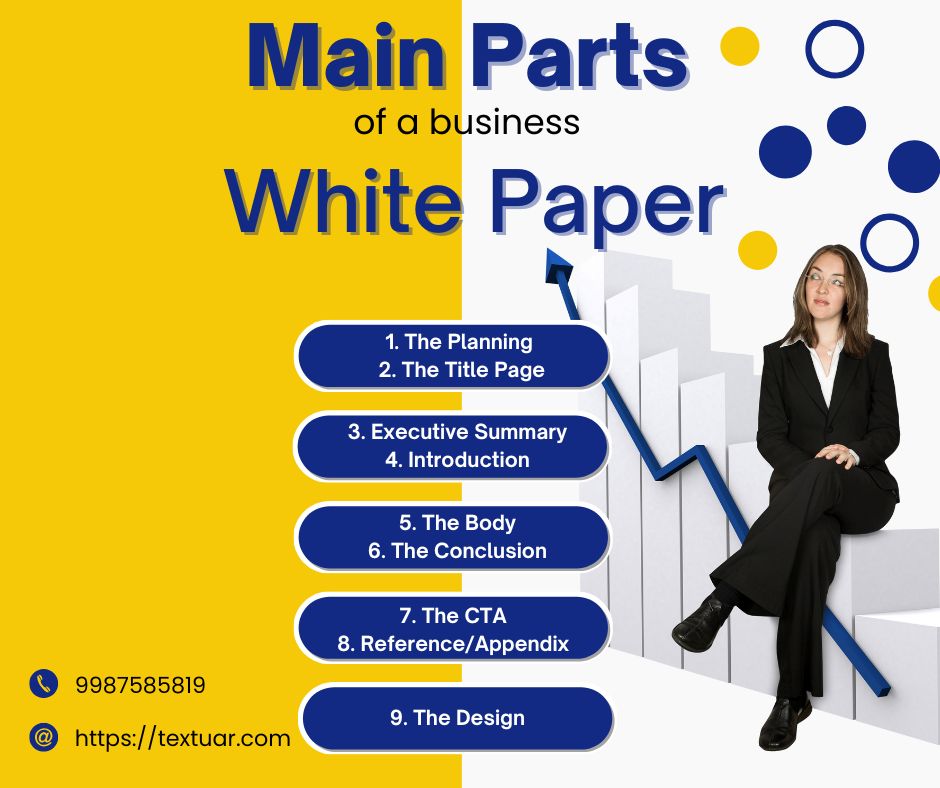Many people consider content writing to be merely filling a page with random words. But in my experience over the last 15 years, I have come to view it as a strategic process. It is true that businesses may want to leverage well-articulated content to educate their audience or persuade them to take a certain action. However, there is an additional goal that is extremely crucial for content writing. It is optimizing the content for better ranking positions on the Google results page. You can achieve this by complying with content writing guidelines crafted by Google.
It is this area of content writing that is incredibly hard to master. I view it as a subtle game of SEO-specific content writing that differentiates the best from the rest. I have seen so many companies that have been successful in creating an online presence just by adhering to guidelines issued by search engines like Google.
In this interesting post, we will take a journey through the intriguing space of creating high value text content by adhering to Google guidelines. When you meet this complex goal, your page is likely to rank high on Google SERPs or search results.
What are the Guidelines for Writing Content for Google?
Content writing guidelines by Google stress on writing content from a user-centered, credible, and content-rich perspective. Such top-tier content seeks to satisfy the needs of the people rather than aiming at higher rankings in search engines.
Here is a breakdown of key takeaways for a content writer:
1 – Self-assessment of Credibility of Content Writing
In the process of creating content, the creators will need to determine the credibility and value of the branded content for the public by getting ideas from reputable sites.
You can implement surveys and polls by targeting your readership so they can assess the advantages and validity of your content. Try to quiz people who don’t know your site. You can do that by hosting focus groups to determine impartial feedback.
2 – Content Quality Matters
The content must be said to be original, comprehensive, free of errors, not plagiarized, credible, and informative. The title should be catchy, with the focus of the show being the main thing, and not be hasty to produce also.
Think of making resourceful manuals or whitepapers that are comprehensive and detail-oriented. These manuals uniquely provide exclusive insider looks and analysis.
You can even publish case studies/research papers in the form of original findings that are consistent with the corresponding knowledge in the sector in which you operate.
3 – Put User-Centric Content
Create posts that not only address your target group’s needs and desires but are also achievable in the search engine rankings rather than the other way around. It is important to do keyword research to comprehend user intent.
You need to make the content to bring the user’s queries and issues into sharp focus and respond to them.
Try to create interactive information for users in the form of surveys, quizzes, or infographics that will interest and benefit them.
4 – The Importance of Expertise
Content should be authoritative and include citations from original sources. It should sensibly be authored by creative minds. The literary authority of authors may be presented through author bios by displaying the knowledge and qualifications of the writer.
It is a good idea to source guest posts or interviews with such industry leaders. Doing so will help in gaining authoritative points of view on the subject of interest.
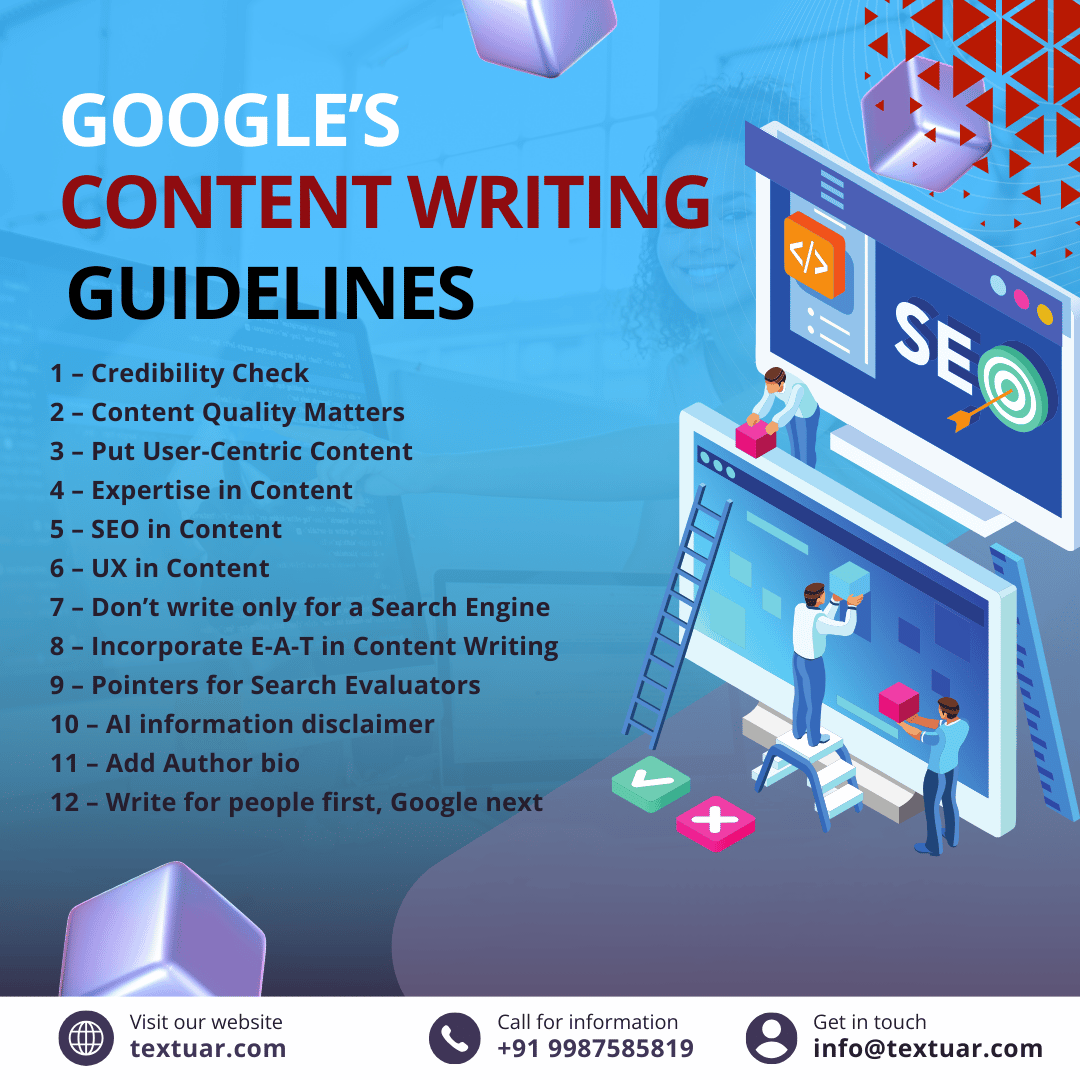
5 – SEO in Content
SEO optimization is one of the essential content writing guidelines by Google. It must consider the interests of users. This will enrich the intrinsic value of the content. Make sure to provide keyword-rich content where the keywords occur in an organic manner.
Since search engines rank web content by how structured and user-friendly it is, you can provide context for crawlers as well as a better experience for users by using meta tags, headers, and alt attributes.
6 – User Experience is Vital in Content Writing
User experience should be put first by sticking to Google’s User Experience Guidelines and building a good site for the user.
You can streamline information architecture to give visitors quick access to principal pieces of content while preserving usability. Try to develop a responsive web design. With this action, you can display the same content and multimedia consistently on different devices with different screen sizes.
7 – Avoid Content That Prefers Search Engine:
Search engine optimization shouldn’t depend on the assignment of content to automated traffic or keyword stuffing to bring users in. Here, we need to focus on crafting articles that are both in-depth and informative in nature.
The blogs or web copy should offer actual solutions. The effort spent on providing rich insights will be followed by thinking of ways to enhance your blog’s SEO.
You need to align to white hat SEO approaches that encourage engagement and natural click-through rates. This approach is better than using black hat techniques like cloaking or keyword stuffing that violate Google’s guidelines.
8 – Incorporate E-A-T in Content Writing
Content is evaluated on the basis of the author’s E-A-T. This means that the more important and trustworthy the information is, the better the value of the content. You need to present your expertise by sticking to accurate data and sources of information. This could strengthen your content. Creating trustworthiness as clearly written by the authors, their personal interests, and factual data would be the mark.
Also read: How to create content as per Google guidelines
9 – Pointers for Search Evaluators
A quality evaluator’s job is to make sure that content is meeting the high benchmark of E-A-T, thereby drawing the algorithm towards these standards. You need to connect with Google’s Search Quality Evaluator Guidelines
Doing so will help to gain insights into criteria applied to rate content by quality and relevance. You may look for recommendations from third-party evaluation teams or remote experts. They will show what needs to be improved to demonstrate content quality.
10 – AI information disclaimer
Users need to be informed about the use of AI or automation where required. Plus, you need to offer clear explanations on how they will be used. When you communicate about the use of automation or AI in content creation, you determine users’ awareness of their part and their capabilities.
Try to add a user feedback mechanism that will help us collect input from users. This will improve the machine learning algorithms in the future.
11 – Author bio to cover the “Who, What, and How”
Content must be directed towards the significant questions around the authorship. It needs to clarify with readers about how the data was collected and what is the industry authority of the blog’s author. For this, you can attach an author bio with the blog.
When you create an author’s bio strategically, it helps. Your site can ensure the popularity of the content by attributing the content to the specific authors/contributors and providing insights about their expertise and background.
It can even explain the way of developing content using research sources and fact-checking processes.
12 – Write for people first, Google next
The first objective of the content writing is to write for people first and Google second. You can add content objectives in line with the user’s needs and wishes. This will put an emphasis on user satisfaction and usefulness more than search engine optimization.
Try to embrace the Google Webmaster Guidelines and Antispam Policies, thereby ensuring ethical content creation and avoiding penalties.
How to adhere to Google’s content writing criteria to rank well?
Getting Google’s high rankings needs content created through a strategic move. The tactic needs to comply with Google guidelines.
Here are actionable tips for writing content that ranks:
1 – Prefer quality over quantity
Make sure to secure your content quality by writing detailed and relevant content. Such blogs or articles will bring value to readers. Forget putting out hundreds of articles that are not of any value to your readers.
You can organize a content audit to uncover and delete poor-quality or duplicated content. For that, it is vital to pool resources to focus on covering crucial or trending topics.
2 – Utilize both external and internal links
To create a transparent user experience, embed internal links for the page connections. Also, make sure to add external links for credibility and references. You can develop a list of responsible external links and credit them per renowned sources related to the blog content.
Doing so lends weightage. It proves your points as well as better answer the reader’s query.
Also read: All You Need to Know About Internal Linking
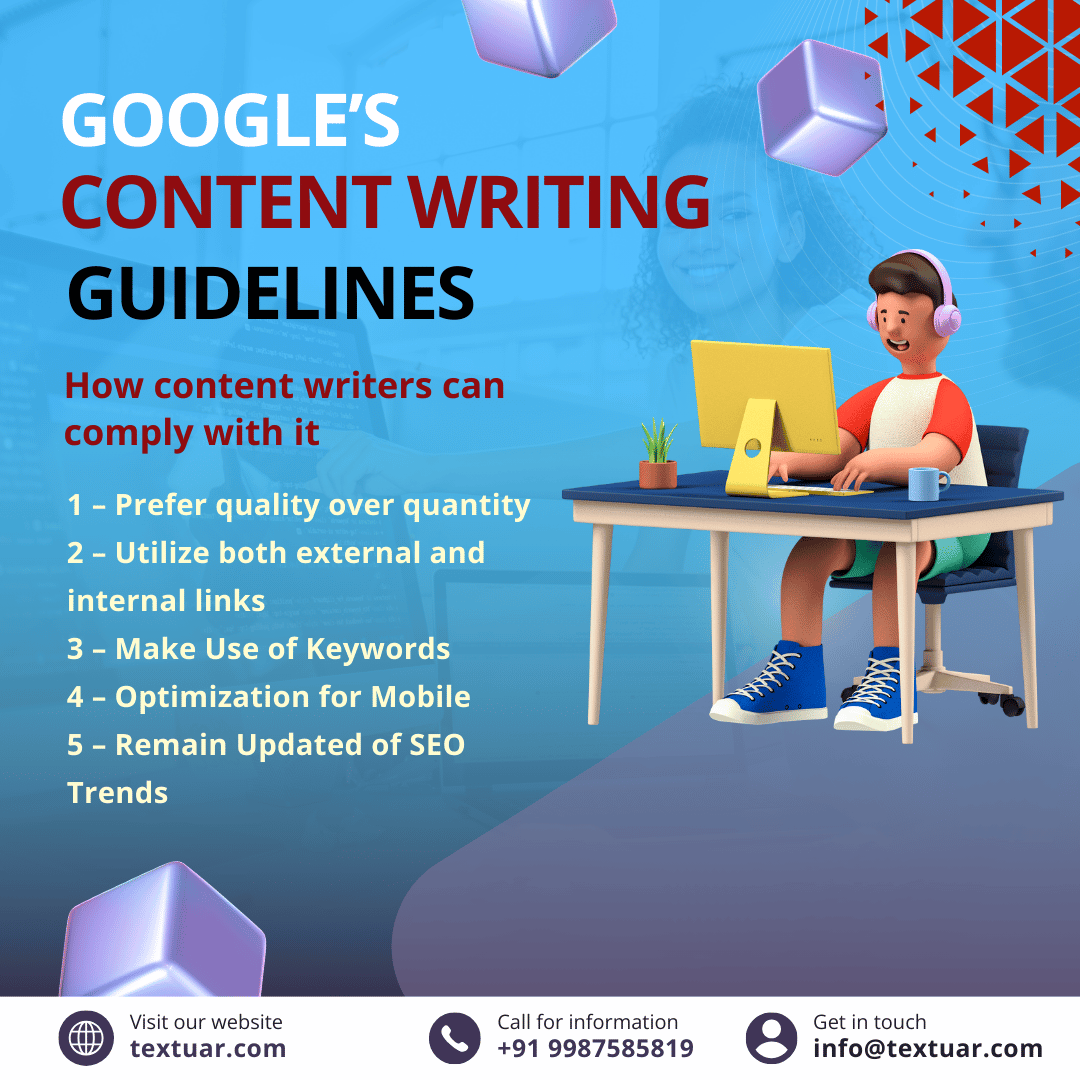
3 – Make Use of Keywords
As a content writer you can use relevant keywords organically in your content. This assists a lot in obtaining better search ranking results. But you need to do this in such a way that it doesn’t come in the way of the people’s reading experience. This is one of the crucial content writing guidelines from Google.
You can implement context-aware keyword approaches such as long-tail keywords and semantic variations. This action captures the audience-specific segments and searches well.
4 – Optimization for Mobile
Make sure that your content is mobile device friendly, as Google has adopted mobile-first indexing criteria to improve user experience.
You need to ensure fast load speed of the pages and eliminate mobile access difficulties. Some issues include fonts that are too small or clickable elements that are too close together.
Also read: 4 Tips to Drive Mobile First Blog Writing
5 – Remain Updated of SEO trends
It is essential to continuously track the algorithm’s updates and market tendencies in order to align your content strategy and keep its perfect performance.
You can attend training courses and participate in other learning activities that help your professional life. Doing so will contribute to the improvement of your content writing, SEO, and digital marketing talents.
Google’s Perspective on Writing SEO-Optimized Content
The skill of SEO-optimized content writing entails a perfect blend of technical skills and creative art. This fusion strikes the right chords of the readers as well as the search engine algorithms.
Here’s a deeper dive into Google’s perspective on SEO-centric content creation:
1 – Consider AI Overviews
In 2025, Google rolled out AI Overviews to keep up with the surging dominance of AI. For a content writer, the optimization entails 2-3 core factors-
a. Consider Search Intent
When you get the search intent right, you make it easier for AI Overviews to cite your website. You need to first check whether a query seeks information, comparisons, or solutions. You can use the ‘People Also Ask’ section on SERP to understand related questions. Also, it is essential that your content should provide concise and direct responses. This way, matching intent improves visibility in AI-generated summaries.
b. Format Your Content so that it is Easy to Read
AI Overviews likes content that is scannable and easy to read. Here, you can do some formatting like-
-Applying H2-H5 heading labels,
-Add a summary at the top to briefly explain what the blog is about (a TL;DR),
-Add tables or lists (like this one), and
-Provide FAQs at the end to help readers.
With this clarity in formatting, there is a higher chance of AI Overviews extracting your content and displaying it on the AI summaries.
c. Create Comprehensive Content
In-depth content comprises detailed, authoritative answers, and AI Overviews favour such quality content. You need to make sure that your content covers all possible subtopics about a chosen topic for the readers. You should use original examples and cite expert sources to lend better credibility to the content. Long-form content of more than 1500 words often works well with AI Overviews, but make sure to give priority to quality over quantity.
2 – The Technical Basis of Writing Content that Delights
Analyzing user intent, searching for keywords with optimal search volume, and optimizing the structure of the content are basic steps to content writing. Make sure to apply the keywords related to your business in the right place.
Applying these steps can help you to become more noticeable on search engines. As a result, you will get a lot of visitors who are genuinely interested in your product or business.
3 – The Importance of Google Ranking
Search engine optimization is vital in delivering top-tier visibility on search pages. It is the key to building a reputation within your niche and remaining visible throughout the web.
You need to put into action on-page and off-page SEO tactics. Doing so will drive the search rankings up. These search rankings will be advanced through
- the use of meta-tag optimization,
- tactical link building, and
- content promotion strategies.
4 – Miscellaneous Tips for Writing SEO Content
In addition to the above tips, this section looks at some more content optimization techniques. Applying them will aid your effort to abide by the Google’s content quality guidelines.
Inviting Titles
Your titles should be attractive and are integrated with the keywords. In my experience, this is a great way to increase click-through rates and influence search results.
Scannable Content
Divide content into easy-to-consume pieces. This can be done via short paragraphs and sub-headings. When you do this, you can ensure that reading and skimming becomes effortless.
Apply Visual Media
Increase user engagement through visual content. They include pictures, infographics, and videos integrated with text information. These help to give a visual appeal.
Meta Descriptions
Organize words in your meta description smartly to abide by Google content writing guidelines. It should elaborate on the main idea behind the content. Plus, it needs to be keyword-rich. This will compel them to click through to your website and be re-directed from the SERPs.
Also read: 6 Tips to Write Compelling Meta Descriptions
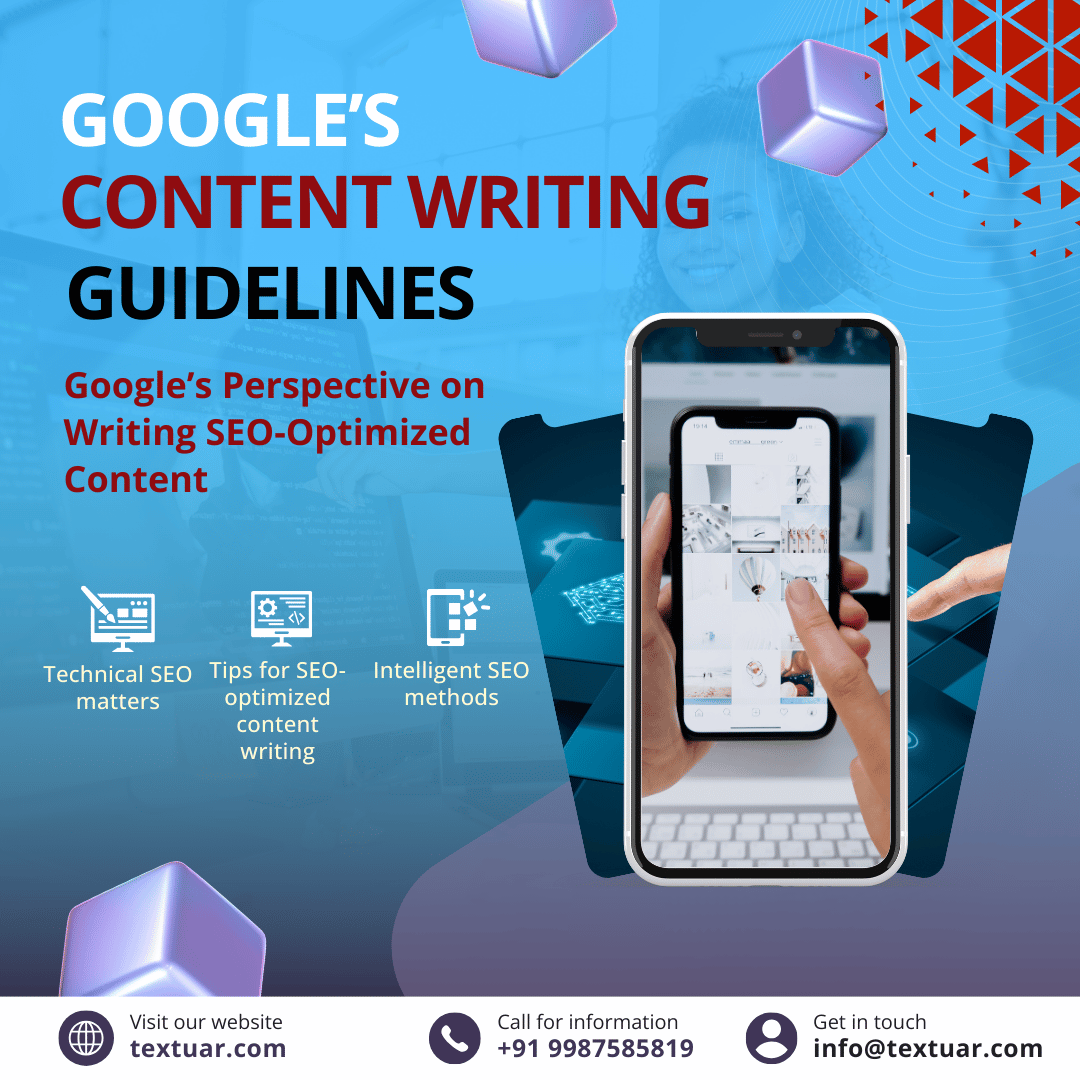
5 – Intelligent SEO methods
Apply these smart SEO strategies to get more exposure and better search rankings.
Semantic SEO in content writing
To amplify the context and depth of posts, use latent semantic indexing (LSI) keywords. These will make it more relevant to search engines. Plus, this action helps generate a higher ranking.
Page Speed Optimization
Boost website performance and load speed with the goal of providing a good user experience. This will also exceed Google’s guidelines for higher search rankings.
Schema Markup
Through structured data markup schemes, we are able to inform search engines of crucial data about content. This helps search engines to generate richer search results and snippets.
Work with Subject Clusters
Building a content framework that revolves around topic clusters and pillar pages. Such a framework drives better topical authority and linking infrastructure. This will enhance internal linking competence and search visibility.
Mobile-Friendly Design
Generate content and design a website with a unique mobile device optimization mechanism. Doing so helps you meet the needs of mobile users who are rapidly growing in number. With it, you can also respond to mobile-first indexing of Google.
Backlink Strategy is Vital for Content Writing
Initiate a thorough plan of link building that includes high-quality backlinks from highly authoritative sites like Wikipedia. This will provide search engines with a reliable and proficient picture.
Prevent Cannibalization of Keywords
Do not oversaturate the website with the exact keywords on different pages. This leads to keyword cannibalization. It is good to remove duplicated content. It is essential to emphasize words that differentiate one page from others on your website.
Putting Accelerated Mobile Pages (AMP) into Practice
Produce lightweight, quick-responding versions of each webpage. This step benefits your mobile visitors. The action helps you stand a chance of featuring in Google’s mobile search results.
Ongoing Content Evaluation
Regularly monitor and upgrade the content to make it the most up-to-date, correct, and in line with the most recent industry trends. This move will help a lot in boosting its ranking on the search list.
Make Use of Video SEO
Another good idea is to create SEO-friendly video content. You can optimize it with pertinent keywords, clear titles, and complete transcripts. This helps with both, accessibility and search.
Make Featured Snippets Your Choice
Rearrange in a way that provides short and exact responses to commonly searched user queries. It can increase the chance of your content appearing as a Google-featured snippet. This will also rank them higher within the search engine results.
6 – Technical optimization that might set your content apart
Technical features have a real impact on the success of your content compared to that of other competitors in the online space. Employing these methods allows you to effectively increase the blogs’ visibility. It also enriches the credibility and accessibility of your content.
Optimize the Images
Compress pictures by using smaller file sizes. Also, give images meaningful names to optimize images better. You can even add alt text to the image to comply with Google content writing guidelines.
Canonical Tags
Apply canonical tagging to show which of the duplicate/similar pages you prefer. Doing so prevents instances of duplicate content and aggregating signals to search engines.
Turn on HTTPS
Secure your website with HTTPS encryption. The move is essential to protect user data and improve the trust factor. This will also boost search engine rankings.
Work with Structured Data
Apply structured data markup to your content elements by employing schema.org vocabulary. These provide search engines with a basis for their content understanding. This move will help your content come up on rich snippets and knowledge panels.
Why Should You Comply with Google’s Content Writing Guidelines?
Being faithful to content writing guidelines from Google is vital for online success. That’s because there are a few reasons for that: These specifications act as a sailor compass, giving you a detailed and complex course for developing and optimizing your online content.
You get elaborate and valuable insights on how to do it in the most effective way that complies with the approved practices of the most powerful internet search engine.
With this step, website authors make sure that they develop unique articles that serve the user’s interest and Google bots.
To conclude
It is now clear that following Google’s Content Writing Rules presents a massive competitive advantage to a website. When you comply with these mandates, you can maneuver your way through the complicated world of content production and optimization. It offers a lot of certainty and clarity on how your content is to be created.
Your online presence gets a tremendous boost with-
- user-focused content
- portraying authority and reliability,
- making good of the latest SEO techniques
You can win big on these goals by abiding with the content writing guidelines by Google.
If you need a strong voice to convey your message and rank well on Google, then it is a good move to connect with Textuar. Our content writing agency in India is at the forefront in creating valuable and rich content. The blogs and articles developed by our writers bring your targeted readers closer to your brand.





